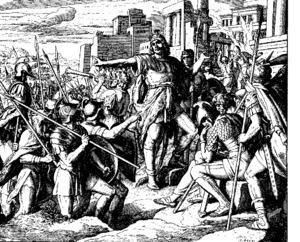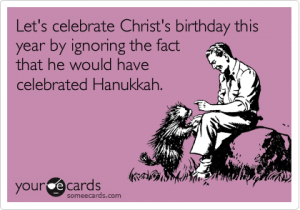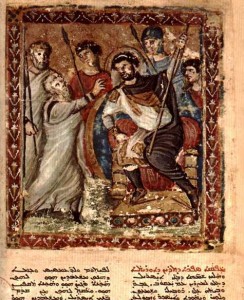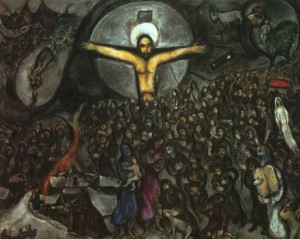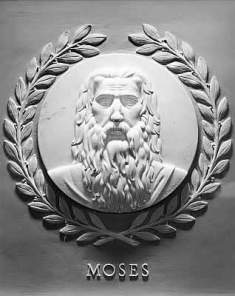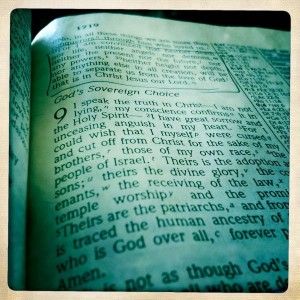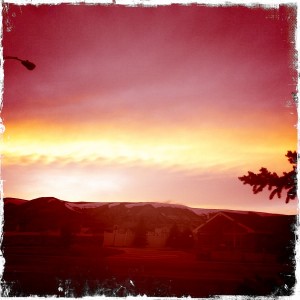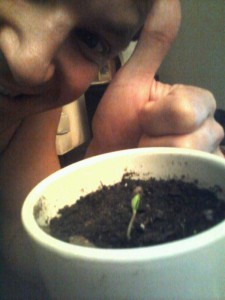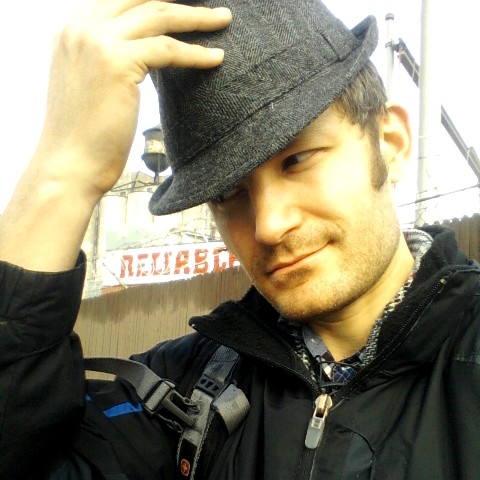What Hanukkah Means to Us
18 Dec 2011 15 Comments
in Holidays, Jewish praxis, The 2:16 Ministries Network
This post talks about why Hanukkah is so great, why Jewish people like me who are strongly connected with the Church love the Festival of Lights, and how anybody interested in the connections shared between Christianity and Judaism detailed in the New Testament can be enriched by observing this holiday. In fact, I would go so far as to say that it is one of the easiest, most biblically rooted ways to recover more of that spiritual, community-located “reason for the season” goodness that can be overwhelmed by the rampant, consumerist commercialism surrounding Christmas in the West. (Yikes! Where did that come from?) But first, a personal admission:
I was raised in a household with a Jewish father and a non-Jewish mother. In the past, this arrangement would have been rare and suspect among American Jewry, but times have changed. According to the landmark National Jewish Population Survey of 2001 helpfully summarized by Liza Katz in her About.com article on Jewish intermarriage, the incidence of interfaith households in the Jewish community has risen nearly 400% over the last thirty years in the States. Whereas roughly one out of every ten Jews got married and raised a family with a non-Jewish spouse when my father was growing up, about half of all Jews make this decision today in America.
A substantial reason for this growth in interfaith marriage among Jewish people is the trend towards secularization and cultural assimilation prevalent amidst the religious and ethnic community in the States. That was certainly true of my father’s side of the family, such that I probably would not have grown up with much exposure to Hanukkah at all if it had not been for the deep interest in the holiday that my non-Jewish mother possessed and wanted to impart to her children. (So, for any of you pure-as-the-driven-snow Jewish types smirking at the mention of my “shiksa” mom, back your farkocktah attitude down or I will love and tolerate the shtik out of you.)
See, Hanukkah is actually a pretty minor holiday by rabbinical standards. In fact, it is the proximity of Hanukkah to Christmas that has yielded a greater degree of attention in contemporary society to the festival than has been the case in the past. Nowadays, you can actually purchase books like Daniel Novack’s My Two Holidays: A Hanukkah and Christmas Story, pick up a “Hanukkah tree topper” for your…er…Hanukkah bush, and satisfy your sweet tooth with blue and white, Hanukkah-themed candy canes from the comfort of your web browser today. That’s how much cultural amalgamation has occurred due to the secularization of the Jewish community when it comes to this holiday.
Consequently, my family did not do the greatest job celebrating Hanukkah when I was growing up. We put forth a valiant effort, but we basically grabbed a bunch of different sources and mushed them altogether to form our own celebration that bore only a vague resemblance to the real thing. But, man, am I ever grateful for this. Even this halting, not exactly kosher way of celebrating the holiday helped to keep that little Hanukkah flame lit in my heart, and when I approached adulthood, I decided to take an honest crack at observing the holiday in closer harmony with what scripture and Jewish tradition have to say about it as a result.
I’ll never forget the first time I celebrated all eight nights of Hanukkah. I was dirt poor, living in Uptown, Chicago. My experience lacked virtually every single trapping typically associated with the holiday–no siddur, no menorah, no dreidel, no supportive community of fellow Jews, no gelt or latkes or anything. I looked all the prayers up online and printed them off so I could recite them without distraction. I fashioned my own menorah from cardboard and tea lights, and I celebrated the entire holiday in quiet solitude with God.
It was the single most spiritually moving thing I did that year. I wept every time I lit those candles and stumbled through those prayers. When you’re doing Hanukkah right, night falls partway through the process. So, the only thing illuminating my flat were tiny flames dancing above a couple globs of liquid paraffin, reminding me of how precious God’s provision had been for the Jewish people as they struggled with a return from exile and a perpetual threat of annihilation, when the Lord worked a miracle between the silence of the prophets and the birth of my Messiah. It was as if the bits and pieces of my identity as a fractionally Jewish follower of Jesus were being knit together again every evening that I prayed those prayers, as if the Jewishness and the Jesus-ness of my spirit that my family had neglected until my father’s generation were finally beginning to grow again after decades of atrophy.
Although I knew the gist of the story of Hanukkah before then, I had never read the passages in the apocrypha like 1 Maccabees 4 that described the events upon which the holiday is based. I knew that about 150 years before Jesus was born, the Jewish people lead by Judah Maccabee had ousted a powerful group of invaders lead by Antiochus IV, a Seleucid ruler who sacked Jerusalem, erected an altar to Zeus right smack in the middle of the temple, banned circumcision, and ordered ritually unclean animals like pigs to be sacrificed in the temple on the altar he built according to the Jewish historian, Josephus. But I did not realize that it was the Talmud–a collection of rabbinic discussions about Jewish law, ethics, philosophy, customs, and history forming the doctrinal foundation of mainstream Judaism–that described the specific miracle most Jews associate with Hanukkah today, i.e. God’s enabling the temple’s lamp stand to burn for longer than it should have given the shortage of oil in those days after the Jews purified and rededicated the temple to the Lord following the expulsion of the Seleucid invaders. Now, I got to learn about all that stuff on the very days in the Jewish calendar when they occurred, recovering and reinforcing their memory while praying the same prayers Jews all over the world recite to remind themselves of God’s protection and provision in times of trouble.
I already knew that Jesus celebrated various biblical festivals mentioned in the Old Testament, but Hanukkah occurred after the codification of the first covenant’s canon. Consequently, I did not know that John 10 specifically records Christ’s celebration of Hanukkah, calling it “the Feast of Dedication” in most English translations of the Bible. As a result, I had completely missed the significance of many of the specific claims of scripture in their historical and cultural context orbiting this holiday. For example, Jesus shares a debate with some other Jewish teachers during the festival at a particular area of the temple called Solomon’s Porch or Solomon’s Colonnade. This was not built by Solomon during the days of the first temple roughly 950 years before Jesus walked the earth. Instead, this structure was most likely developed as an expansion of the second temple built by the Jews after they returned from exile, i.e. a part of the temple whose dedication back in the days of Judah Maccabee was the basis of the celebration of the Festival of Lights in the first place.

Tetradrachm of Antiochus IV. Reverse side pictured on the right includes the Greek inscription, "ΒΑΣΙΛΕΩΣ ΑΝΤΙΟΧΟΥ ΘΕΟΥ ΕΠΙΦΑΝΟΥ ΝΙΚΗΦΟΡΟΥ," which translates to "Basileus Antiochus, God Manifest, Bearer of Victory." Retrieved from wikipedia.
And since that festival specifically commemorated the ousting of Antiochus IV, it was not until I learned a bit more about the guy that I understood how brazen Jesus’s words in John 10 must have seemed. Not only was Antiochus IV a pretty bad dude in general, he was so self-absorbed that he broke with his own culture’s traditions to apply the term “Epiphanes” (Gk. “God made manifest”) to himself. The guy was so crazy that some of his contemporaries lampooned his assertions of divinity with their own play-on-words nickname, “Epimanes” (Gk. “the mad one”). So, when Jesus says that he and the Father “are one” in John 10:22-33 while accepting the title of Messiah, a Hebrew term meaning “the anointed one” of God, he was doing that at the exact time of the year when Jews celebrate the ousting of Antiochus IV–a murderous invader who made the same sorts of claims to divinity. That’s why the other Jews accuse Jesus of blasphemy, of which he would have absolutely been guilty unless he was actually telling the truth. That’s why everybody got so upset that they tried to literally stone Jesus to death. Similarly, when Jesus claims in John 10:34-36 that God the Father had sanctified (i.e. dedicated and made holy and set apart) him and sent him into the world, Christ was drawing a parallel between himself and the very temple upon which he was standing during the specific holiday commemorating that temple’s purification and rededication by the Jewish people.
It was like Jesus was saying, “I am the true, Divine Sovereign this Antiochus IV charlatan falsely claimed to be. In my own body, I am making God known to you because the Father and I are One, and he has set me apart and dedicated me just as our ancestors did to this temple, whose glory will inevitably fade now that the real thing is standing right here before you.” No wonder everybody tripped out at Jesus’s words; my own mind is still blown by all of this. I can no longer read passages about Jesus being the light of the world all over the rest of the gospel according to John–such as John 1:1-18, John 3:16-21, John 8:12, and John 9:5—without thinking of Hanukkah. It finally clicked for me a few years ago how all this stuff was not just a useful metaphor about Jesus’s activity or being in general but a hint towards a specific, mystical union of concrete reality and symbol running through Israel’s history and scripture right up to Jesus’s birth, life, ministry, death, resurrection, and ascension to heaven. All this was just one more example of how God’s method of protection and love for the Jewish people was a shadow and a sign of the full reality demonstrated in Messiah as Hebrews 10:1-18 puts it, of how Jesus is the telos–i.e. the consummation or the appointed fulfillment–of the Mosaic Law as Romans 10:4 describes the matter.
Jesus was not just celebrating Hanukkah in John 10, he was illustrating his fulfillment of it. And one of the best ways to let these truths structure my life, to let them truly sink in and form the basis of the way I live in the day to day, is to continue to celebrate them each year during the Festival of Lights, just as Christ and his disciples did but also with the knowledge of Jesus’s fulfillment of the holiday in his person. Thankfully, American culture hasn’t found a way to really leverage Hanukkah for much commercial gain at present. And this means that we don’t have to put up with wave upon wave of Hanukkah-based advertisements, initially endearing but utterly irritating songs on Lite FM, snarky allegations of the pagan underpinnings of the holiday, or kvetching by people distraught about how God has been stripped out of Hanukkah by all those secularists whom we few and faithful must combat for Judah Maccabee’s sake or something.
Even if you don’t posses a Jewish background, there is this awesome, ninja-like move you can make by celebrating Hanukkah if you want to transcend and in a sense redeem the cultural baggage surrounding the Christmas season thanks to the ways the dates usually work out each year. Do you have any idea how freaking cool it is to be able to celebrate Advent throughout the whole month of December, then drop some Hanukkah action right in the middle of it for a whole week? And when things really line up like they will this year, you might even get to celebrate Christmas Eve and Christmas Day right in the middle of Hanukkah. It’s like circles within circles, man… And nothing eclipses concerns about the commercialization of or pagan elements running through Christmas quite like throwing down some Judaica, with traditions and prayers and ways of thanking and worshiping God that predate Jesus’s birth by over a century comprising a holiday that he himself celebrated–during the specific part of the year and in many of the particular ways that he and his followers celebrated it. (You know, unlike Christmas, which I also love.) And if you do possess a Jewish background, I probably don’t have to explain to you how great it is to dig deeper into the roots of this holiday rather than let goofy tchotchke on Amazon.com or Stephen Colbert vs. John Stewart’s “Can I Interest You in Hanukkah?” define your experience.

Yours truly at the Christkindlemarkt with gigantic menorah, compliments of the Lubavitcher's of Chicago
This is what Hanukkah means to Jewish followers of Jesus like me. We are people whom God has miraculously preserved despite our lack of merit and mutt-like pedigree by calling us to himself through the light of Jesus and making us whole again–not just with a growth of integrity in our identity as followers of our Jewish Messiah but as a categorically new people unified with our non-Jewish brothers and sisters through our Savior’s body, as Ephesians 2 puts it. Hanukkah is one of the reasons why I continue to work for that unification to this day, one of the ways I try to follow Jesus’s example by presenting my own body as a “living sacrifice” to God as Romans 12:1-2 puts it rather than go my own way as did generations of my father’s side of the family in their bit-by-bit abandonment of their traditions and relationship with the Living Lord of All. There are few things that are so simultaneously humbling and yet motivating, so challenging and yet rewarding.
If any of this resonates with you, here are some practical tips about exploring Hanukkah this year. We’ll be celebrating the holiday this time around from sundown of Tuesday, December 20 to nightfall of Wednesday, December 28th, which corresponds to the 25th of Kislev to the 3rd of Tevet of the Jewish calendar:
- Read up on your Hanukkah basics – I mentioned most of this already, but a good place to start is 1 Maccabees 4, section 34 of the first chapter of Josephus’ Jewish Wars, and the story of Hanukkah summarized by wikipedia or Judaism 101.
- Explore Jesus’s celebration of the holiday – Just check out John 10:22-42 and scope out this article by Gordon Franz on the topic.
- Join some other folks celebrating the festival – If you’re in the Chicago area, feel free to connect with the posse meeting at my place by checking out the open facebook event. If that’s not possible, consider visiting one of the Messianic Jewish congregations or ministries all over the world, such as those listed on the UMJC’s database or the IAMCS’s database.
- Hook yourself up with some Hanukkah gear and prayer resources – Maybe you want to take a crack at this Hanukkah stuff on your own, much as I did several years ago. The key prayers before you light the candles are listed here, and the prayer after you light the candles is here. If you don’t want to slap together your own hick accouterments like I did back in the day, you can pick up a legit menorah and some candles with expedited shipping from Amazon.com just in time for Tuesday night. Plus, that Judaism 101 link mentioned above includes a number of songs and recipes and games traditionally associated with Hanukkah.
- Take your time – Hanukkah provides a great opportunity to put the breaks on busyness and re-calibrate your focus on God. Don’t rush your observance of the holiday; carve out the time to let the Lord work in and through your heart as you explore this way of celebrating God’s protection and provision in this place and time, just as God did in days of old at this season.
Baruch HaShem…
The End of Moses and the Beginning of the Year – Part 2
12 Oct 2011 Leave a Comment
in Bible, Jewish praxis, Theology
Around two weeks ago, I posted the first part of this series exploring the connections between the last narrative section of the fifth book of the Bible and the Jewish high holiday, Rosh Hashannah. Since the article I posted before this was also on the long side and dealt with some heavy topics, I broke things up a bit in my last post by delving into an exploration of the concept of lived simplicity. Although we have now passed the time in the Jewish calendar devoted to Rosh Hashanah, there is still quite a bit I would like to share by developing the preliminary work I did two weeks ago. So, this post will pick up where we left off back then in order to dig into the meat of Deuteronomy 29:9 – 31:30, showing how this portion of scripture so beautifully lays out key aspects of one of the most important biblical holidays, which is traditionally celebrated by Jews right around the same time each year that many of them are meditating on this portion of scripture.
My goal in the previous part of this series was to prepare the grounds for this process by highlighting various aspects of Jewish life and practice that are intimately tied to both the text and the holiday in question. My hope is to facilitate a robust engagement with the cultural context in which this portion of holy scripture is frequently read by the religious community that received it, which will in turn enable us to engage with God in a unique and vital manner often neglected in the church. Among other things, I mentioned how the Jewish rabbis partitioned the Torah, the first five books of the Bible, into sections called parshas that one can study sequentially each week over the course of a year. In fact, if you ever visit a synagogue to participate in a service of worship on Shabbat (more popularly known in English as “the Sabbath,” the seventh day of the week), you will probably hear a message delivered by the presiding rabbi that analyzes the parsha for the week. The parsha for the week during which Rosh Hashanah occurs is our text, Deuteronomy 29:9 – 31:30.
Last time, I also discussed how the Jewish calendar works quite a bit differently than the Gregorian or Julian calendar. It marks its first year from the date the rabbis calculated back to the creation of humanity such that we are presently living in year 2011 C.E. according to the Julian and Gregorian calendars and year 5772 according to the Jewish calendar. Also, there are not one but four different points marking the beginning of the year for the Jewish calendar, Rosh Hashanah being one such point commemorating the new year from a perspective celebrating the creation of the world and ramping up over ten days to Yom Kippur, the holiday commemorating God’s process of atoning for the sins of the Jewish people and thereby reconciling them back again to a restored, righteous relationship with God.
This time around, I will pivot from describing the praxis of the celebration of Rosh Hashanah and the reading of Deuteronomy 29:9 – 31:30 in the Jewish community today to laying out the biblical context of the text in question. I want to plow into this parsha to answer four different yet interrelated questions: 1) Just what is going on in this text in general, 2) how does it relate to the holiday of Rosh Hashanah during which it is traditionally read, 3) what on earth does this tell us about who God is, and 4) what might be our response–how does all this not only serve to inform us but to transform us? So, by the end of this post, we should have acquired both the cultural context in which our text is read by the Jewish community as well as the biblical context in which the text can be found. That will enable us to do the in-depth, exeggetical drilling in the final post of this series to take a solid crack at answering those four questions I mentioned above.
Incidentally, I’m writing this post while rocking out to this song, which you should clearly listen to right now while you’re reading this to capture the synergistically epic nature of the compositional moment. Or maybe this one if you want to swing in a more Jewish direction or something…
Okay, Deuteronomy received its English title from the Greek term, “Deuteronomion,” which means “second law.” This refers to the recapitulation of much of the teaching delivered over the previous three books of Torah–Exodus, Leviticus, and Numbers. These books tell the story of God’s deliverance of the Jewish people from slavery in Egypt through Moses, one of the single most important prophets and leaders mentioned in the entire Bible. According to Exodus 33:12 34:35, Moses is the only individual mentioned in the entire first half of the Bible who gets a glimpse of God’s glorified presence; in fact, Moses’ countenance became so radiant from this encounter that he terrified other people who saw him afterwards such that he walked around with a veil over his face to keep them from flipping out. Numbers 12:3 describes Moses as being “more humble than anyone else on the face of the earth,” and yet God worked so powerfully through him that the Lord himself said that he had made Moses “like a god” to others with whom he came into conflict, such as the king of Egypt in Exodus 7. In fact, Exodus 34:10 says that God spoke with Moses “face to face,” and Numbers 12:8 says that Moses spoke with God “mouth to mouth,” which are parallel literary devices indicating a degree of intimacy in communication greater than virtually anyone else in the entire Bible. (Remember, not even Moses could handle actually looking directly at God face to face according to Exodus 33:12 and following.)
Given all of the above, it is little wonder why the final redaction of Deuteronomy 34:10 indicates that no other prophet had arisen in Israel like Moses ever since, a person whom “the LORD knew face to face.” Now, all those capital letters that get brought into most English translations with this verse indicate the most holy iteration of the name of God in the Old Testatment, nicknamed “the Tetragrammaton,” which means “the four letters.” Why such a strange moniker? Because the Hebrew text doesn’t actually spell out the entire name of God in this case; it was thought to be too holy to even write out in this form. Instead, there are just four Hebrew letters present in the text–yodh, he, waw, and he–and the rabbis actually mixed in some different vowel markings over time to prompt any reader following along to use a completely different word at this point when reciting scripture aloud out of reverence, namely the word, “adonai,” which is the Hebrew term for “lord” or “master.” In other words, Deuteronomy 34:10 is juxtaposing the single most holy name of God with the statement that God knew Moses “face to face.” That’s as freaking intimate as it gets all the way until Messiah Jesus, the Son of God, shows up in the New Testament. This is probably why John 1:17-19 purposefully states that “the Son” is “himself God,” that he is in closest relationship with God, that he is the only one to have truly “seen” God, and that he has on this basis “made God known” to those who follow him.
To continue with Moses, it is little wonder why the rabbis concluded that the person he identifies in Deuteronomy 18:15-19 as being one whom God would raise up as a prophet “like me from among you, from your fellow Israelites” must undoubtedly refer to the Messiah, the chosen and anointed one of God. (Of course, most rabbis do not conclude that this Messiah is Jesus, but that’s a topic for another time.) It is also little wonder why Moses shows up not once but twice in the closest thing we have to a comprehensive statement of faith for the Jewish community today, Rabbi Moses ben Maimon’s “13 Principles of Faith.” And that is also why it must have been utterly terrifying for the myriad Jewish people who had followed Moses for decades through the wilderness towards the Promised Land around the present-day State of Israel to even think of moving forward without Moses’ leadership.
But the twentieth chapter of the book of Numbers indicates that Moses would not survive the Jewish people’s journey from slavery to wilderness to homeland. In fact, almost nobody who had initially been delivered from slavery in Egypt survived that journey, and that is why the final book of Torah, the fifth book of the Bible, gets that nickname Deuteronomy, “second law,” because it was Moses’ last chance to reiterate in detail precisely what God had done on behalf of the Jewish people and what the terms of God’s covenant relationship with them was. That way, all the children of those who had directly witnessed God’s miraculous deliverance back in Egypt, those children who had quite literally grown up wandering around in the middle of nowhere between bondage and promise, would never forget who God is and what God had done–even if their parents’ had not related the story so accurately up to that point.
To really bring this point home, Moses not only reiterates the gist of the teaching recorded in the previous three books of the Bible across the text of Deuteronomy, he also boils all of it down into what is the closest thing to a central confession of faith for the Jewish people, the Shema. This is recited at every single Shabbat service of worship, and it’s the very same portion of scripture that Jesus himself quoted when asked what the greatest commandment in all of the first five books of the Bible could be. It’s right there in Deuteronomy 6:4-5, “Hear, O Israel: The LORD our God, the LORD is one. Love the LORD your God with all your heart and with all your soul and with all your strength.” It turns out that this is not just important for Jewish people in general, it’s rather important for the analysis of our parsha; so, let’s take a closer look.
Well, you can see a whole bunch of instances of that exceptionally holy name of God, the Tetragrammaton, in those two verses comprising the Shema. But you can also see several other things when you look into the Hebrew; for the sake of brevity, I’ll mention just a few:
- All of the Jewish people present are implored to “hear.” This isn’t a mere dictation but an attempt to draw into relationship even while informing and exhorting.
- The LORD–the most holy and awesome being in existence–is also the God of the Israelites. God is both transcendent yet also immanent. As Isaiah 57:10 later puts it, “For this is what the high and exalted One says—he who lives forever, whose name is holy: ‘I live in a high and holy place, but also with the one who is contrite and lowly in spirit, to revive the spirit of the lowly and to revive the heart of the contrite.'”
- “The LORD is one,” which means two things at the same time in Hebrew: First, that there’s just one, true God; God doesn’t need to jockey for power among some pantheon like the Egyptian, Sumerian, or Greek concepts of divinity. Second, that this God alone is the God of Israel–a sort of radicalization of the whole transcendence / immanence thing that illustrates the completely different sort of relationship God wanted to share with the Jewish people compared to how others understood their relationship with the divine was supposed to work.
- The bottom line of what God wants, what God commands, is love expressed through every aspect of one’s being. In an ancient, Jewish worldview, the heart (H. lebab) was understood to be the seat of the intellect, emotions, will, and appetites. The soul (H. nephesh) was understood to be the central essence of a person, the very life of a given being. So what base is left to cover in the appeal to love? Nothing! the final phrase that get’s translated into English as “all your strength” is literally something like “exceedingly much” or “abundant muchness” (H. m’od). It’s like God is imploring the Israelites, “I want you to love me with literally everything inside of you–your reason, your feelings, your volition, your passions, your very spiritual essence, your–well, you get the picture–your everything I put inside of you! Because that’s how much I love you.”
That’s why the Shema stands as a summary statement for the entire Torah, because all the rest of the stories and prophecies and commandments hang upon the truth expressed in these two, short verses. And there are repercussions for committing oneself to living accordingly on the one hand or else abandoning such a love-drenched relationship with God on the other hand. Living in the former way guides us towards the sorts of activities that bring wholeness and justice and truth to ourselves and those around us with prosperity being the result; living in the latter way not only severs our covenant relationship with God, it puts us at enmity with one another, too. The consequences of eschewing this love of God, of rejecting the activities predicated on a response to that love, is nothing short of destruction and death; the consequences of turning to God are overflowing life and peace. To make sure the Israelites would never forget this point, Moses separates all of the people into two groups located on two adjacent mountains in Deuteronomy 27 – 28, and they literally shout the blessings that would follow from their obedience to God’s commands from one mountain as well as shout the curses that would follow from their disobedience of God’s commands on the other mountain.
This brings us right up to Deuteronomy 29, the chapter where our parsha starts. If we were to look at what follows immediately after our parsha to round out our understanding of its biblical context, we wind up in a huge chunk of poetry that runs for a solid two chapters–the longest piece of prophecy that Moses delivers in the entire Bible. This is followed by a short, narrative epilogue describing his final resting place somewhere “in Moab, in the valley opposite Beth Peor,” a place that remains shrouded in mystery to this day. Deuteronomy 34:7 tells us that “Moses was a hundred and twenty years old when he died, yet his eyes were not weak nor his strength gone.” Well, dropping a couple chapters of prophetic poetry right before one hikes across a mountain and a valley before giving up the ghost certainly demonstrates that!
Now, ancient Hebrew lacks punctuation. So if one wanted to break up a section of narrative, one would typcially insert a section of poetry. And that’s exactly what the portion of scripture following our parsha is doing; it’s communicating through a Hebrew literary device that this is the end of this part of the story. But that means that our parsha is the very last chunk of substantial narrative in the entire Torah, the last bit of story before Moses delivers the longest and probably the most important monologue of his entire life. This means that whatever happens in our parsha must be incredibly significant. And every year, Jews read about the content of the end of Moses’ life at the exact same time that they are celebrating one of the most important holidays, Rosh Hashanah, the biblically mandated celebration that wound up getting associated with the beginning of the year from the perspective of the creation of the world. Why?
Now that we have explored both the cultural and biblical context of Deuteronomy 29:9 – 31:30 over the first two parts of this series, we can turn towards an in-depth analysis of the text itself to try to answer that question. And also the other three questions I mentioned above. Next time…
The End of Moses and the Beginning of the Year – Part 1
26 Sep 2011 3 Comments
in Bible, Jewish praxis, Theology
For erev Shabbat last week, I got the chance to deliver a parsha teaching at my friend, Heather Blecher’s flat. Heather is an accomplished, young adult leader of Chicago’s Jewish-Christian community, worshiping with an evangelical congregation in Evanston and serving as a senior ministry partner with the Skokie branch of the non-profit, para-church organization, Jews for Jesus. Beyond this, Heather is a gifted photographer who distributes her prints through etsy, posts one shot a day on tumblr, was recently featured on imagekind.com, and occasionally exhibits her work in assorted coffee shops and art galleries across Chicago and New York. It’s always an honor to partner with her, and I’m glad I got the chance to do so once again last week. To spice up this post accordingly, I included a couple of my favorite photos from Heather’s aforementioned tumblr blog, which you should obviously check out, pronto.
My ultimate goal in this post is to set up an analysis of a key portion of scripture that many Jews reflect upon during one of the most important times in the Jewish calendar, the same portion of scripture upon which I taught at Heather’s flat a few days ago. I want to do this from an explicitly Jewish-Christian angle, illustrating just what is at stake for followers of Jesus who want to better understand the Jewish roots of their faith so that they can more faithfully follow after Messiah. In order to pull off this sort of analysis, I have to lay out a prolegomena of sorts describing a bit more about Jewish life and practice so that the biblical analysis I mentioned is achievable at a deep rather than a superficial level. In other words, this post is not merely anthropological but hermeneutical; it is not just about various, whimsical facets of Jewish culture but about the context of holy scripture, our attention to which will enable us to engage with God in a vital way that has been often neglected in the church. My next post in this series will deal with the in-depth, biblical analysis; this post will properly set it up. Let’s get rolling by unpacking a few of those religious terms I casually tossed into the very first sentence of this post. When is “erev Shabbat” and just what on earth is a “parsha”?
Jewish people measure the beginning of a given day from nightfall of the one that precedes it. Hence, a lot of religious observances scheduled to occur on a given day in the Jewish calendar get inaugurated the previous night–you know, because that’s technically already the next day. Hence, there’s a pretty frequent use of the term “erev” referring to the night preceding a given day, which is also the same thing as the very beginning of that day for a Jewish understanding of the ways that days and nights work. If this seems confusing, maybe this analogy will help clarify things a bit. For a Gregorian or Julian calendar, the first day of the week is Sunday and the last day of the week is Saturday, meaning that the weekend starts on Saturday morning and runs through Sunday night. But just about everybody knows that you really celebrate the weekend not on Saturday morning but on Friday night, right? The night before the technical weekend is so wrapped up in the observance of the weekend itself, it winds up getting functionally lumped together in our minds. (And parties, where applicable.) Well, something like this is true for the Jewish observance of every day, except that the evening before a given morning is technically a part of that morning and not just functionally a part of it. The linguistic marker of this fact is the term “erev,” the night before a given day that is also a part of that day.
Incidentally, the effect of this arrangement is such that one often wakes up on the morning of a spiritually significant day that has already begun and has in some part been commemorated before one went to sleep the previous night. To illustrate the significance of this way of doing things, the average, observant Christian does not associate Saturday night with a Sunday worship service, and the average Sunday morning is often frenetically paced. (Some buddies of mine actually leveraged this fact by planting a church in Brooklyn whose Sunday services began at 6pm.) In contrast, the average Jew does associate Friday night with a Saturday worship service, and they will have prepared themselves to participate in the latter with a focused yet relaxed rhythm on Friday night–literally going to sleep and waking up again in a state of rest devoted to worshiping the Living God and celebrating this blessing with their families and community of faith.
The key term in Hebrew for the seventh day of the week is שבת, i.e. “Shabbat,” or what most English speaking people call “The Sabbath.” Not only is this the final day of the week, it is the only day of the week with a proper name in scripture. In Hebrew, the other days of the week are given nicknames for their distance from Shabbat; that’s how ridiculously important Shabbat is for an observant Jew. Moreover, Shabbat it is the only day of religious observance mentioned in what is popularly called The Decalogue, or “The Ten Commandments” recorded in Exodus 20:1-17 and Deuteronomy 5:6-21. These are ten of the most important instructions delivered to the Jewish people out of all 613 commandments articulated in the Torah, the first five books of the Bible, and Shabbat receives more commentary than any other teaching in in those two, aforementioned portions of scripture.
In order to help Jewish people study scripture faithfully each week, the rabbis apportioned various selections from Torah into units for sequential study, called parshas. Each Shabbat, Jews are encouraged to study the given parsha selection, then meditate and act upon it over the course of the following week. So, last Friday night for erev Shabbat, i.e. the very beginning of Shabbat last week, I delivered a teaching on the parsha selection for the group of people Heather had rounded up at her flat. We also shared an awesome time of prayer, laughter, dialog, and the consumption of some utterly delicious food and drink, but those are topics of discussion for another time.
I’m going to move towards wrapping up this post by mentioning one detail that will provide a nice pivot for part two of this series. According to the Jewish calendar, this present week spans Elul 26, 5771 to Tishrei 3, 5772. Whereas the common era calendar measures everything with reference to the birth of Christ circa 1 B.C.E. and 1 C.E. (even though it’s pretty likely that Jesus was actually born around 4 B.C.E.), the Jewish calendar measures everything from the date it has calculated the creation of the world for religious purposes, which corresponds to 3761 B.C.E. The months are also run on a strictly lunar cycle and given different names than, say, the Gregorian or Julian calendars; hence, today is the 27th day of the month of Elul in year 5771 for the Jewish calendar and also the 26th day of the month of September in year 2011 for the Julian and Gregorian calendars.
Now, you may have noticed in the second sentence of the above paragraph that the parsha actually runs right across the new year according to the Jewish calendar; we’re going from the end of the month of Elul 5771 to the beginning of the month of Tishrei 5772. The festival marking this shift is one of the four most important holidays for Jewish faith and practice, holidays so important that one was supposed to suspend all normal work in order to properly connect with God through them such that one could be excommunicated from the Jewish community for callously disregarded their significance back in the days when scripture was being codified. Those “big four” holidays are Shabbat, Rosh Hashanah, Yom Kippur, and Pesach. And just to make things interesting, while it is Rosh Hashanah that functionally serves as the Jewish new year, the day falling right in the middle of the week for which our parsha section is reserved, it is actually Pesach that technically serves as the marker for the Jewish new year.
Sort of.
Alright, I cannot leave this post dangling on such an apparent contradiction; so, here’s one way to understand the matter. The central, religious event for the Jewish people recorded in first five books of the Bible is God’s miraculous deliverance of the Jewish people from hundreds of years of bondage and slavery in Egypt. This single event predicated everything that followed in such a fundamental way that God literally reset the Jewish calendar to commemorate it, and this is precisely what Pesach, also known as “The Passover,” accomplishes. I love how the first couple verses of Exodus 12:1-28 illustrate the matter, where God says to Moses and his brother, Aaron, “This month shall be for you the beginning of months. It shall be the first month of the year for you.” It’s like God is saying, “What I am doing right now on your behalf will blow your minds so much, it is so completely unprecedented, I want you to rearrange your entire year around it.” So the first two weeks of the Jewish year during the month of Nisan are devoted to ramping up to Pesach, and there is an entire week of celebration afterwards named the Feast of Unleavened Bread to protract the lesson. In other words, Jews take three weeks to celebrate the new year, and the most important point of time over that period isn’t the first day of the year but twilight just before the morning of the fifteenth!
A similar thing happens as we go deeper into the year and approach Yom Kippur, also known as “The Day of Atonement,” which commemorates God’s process of making amends or reparations for the sins of the Jewish people and thereby reconciling them back again to God’s self. Remember how we took two whole weeks to ramp up to Pescah? Well, we take ten days to ramp up to Yom Kippur nicknamed “the days of awe,” which begin with Rosh Hashanah. Now, Rosh Hashanah is actually a Hebrew nickname meaning “the head of the year” for the more biblical term in Leviticus 23:24, “The Day of Sounding,” which refers to the trumpets whose blast indicated to everybody within earshot that the gradual ramping up towards Yom Kippur had begun. The Jewish rabbis would later develop the concept of four different new years commemorating the beginning of different parts of our world. Pesach commemorates the beginning of the salvific relationship God established with the Jewish people by liberating them from slavery in Egypt and, consequently, the beginning of all holidays. Perhaps in some part due to the significance of forgiveness and the removal of sins commemorated by Yom Kippur, the rabbis treated Rosh Hashanah as the day when the world was created; that’s why the calendar actually advances a year on Rosh Hashanah and why it gets that nickname, “the head of the year.”
What all this means for our purposes is that the parsha for this week, Deuteronomy 29:9 – 31:30, spans an incredibly significant period of time for the Jewish calendar, the week when observant Jews celebrate the creation of the world and begin to prepare themselves to encounter God on a day devoted to recognizing their need for forgiveness and the removal of sins as a people. I’m going to go out on a limb here to say that the rabbis picked this parsha with care; they meant for us to meditate on the truths of scripture in that aforementioned context of observance and meditation on these key aspects of our relationship with God.
Paradoxically, while Jews are supposed to reflect upon this parsha selection near the end of Deuteronomy over a week that includes a day dedicated to remembering God’s creation of the world, a day marking the turnover of the Jewish calendar and, hence, a celebration of the beginning of the new year in Rosh Hashanah, the actual scriptural content of the parsha marks the end of one of the most important figures in all of the Bible, Moses. What’s the significance of that detail? Well, now now that we’ve done the work of establishing more of a culturally edifying context to explore this passage of scripture, we can turn to an in-depth analysis of it.
Next time…
Germinating The 2:16 Ministries Network
19 Sep 2011 Leave a Comment
in Jewish praxis, The 2:16 Ministries Network Tags: 2:16, apple, catalyst, Christian, cultivate, failure, germinate, grow, Jewish, ministry, praxis, success, theology, tree
This week, I realized a childhood goal by successfully germinating a seedling from an apple. I used to loves apples as a kid; so, I tried all sorts of completely unsuccessful, haphazard ways of producing more apples from those I happily consumed at virtually every turn. Nothing worked–not even freezing the seeds for a couple weeks to simulate their passage through winter. (I was really banking on that one, too.) Eventually, I put the matter aside, figuring I just wasn’t meant to cultivate apple trees. Yet.
Fast forward to a few months ago when I learned how to germinate cucumbers and cantaloupe from my buddy, David Bareford, by drying out their seeds, then stuffing them in the fingers of a vinyl kitchen service glove with a damp wad of cotton. Something about that process suggested a solution for the failed apple growing attempts of my youth. (I rarely take things completely off the range of my life; I just have an incredibly spacious back burner.) I checked around for articles online and found the method for acquiring apple seed growth is almost identical to everything else, except that you must refrigerate the seeds while germinating them in that damp wad of cotton or bit of cloth or something. Bam! I now have about half a dozen properly germinated apple seeds and precisely one precious, viable seedling. I am calling him el guapo because he is so handsomely eager to grow into my first apple tree–you read it here first.
In a lot of ways, my experience with Jewish-Christian ministry is like this. Although I was acutely aware of my Jewish heritage growing up, although I was surrounded by a robust, missionally engaged, Christ-centered community virtually free from the sorts of anti-Judaic tendencies plaguing many ostensibly healthy Christian congregations across the world, my experience with forms of ministry attempting to bridge that Jewish-Christian divide never quite cleared the germination stage. Don’t get me wrong; there were all sorts of great experiences. They just never seemed to coalesce into a healthy, nuanced, transferable, scalable pattern for growth and life in Jesus for me as a self-identifying Jewish follower of the self-identifying Jewish Messiah.
There are a lot of ways to solve problems, and the final resort to which I used to turn during my studies of applied mathematics was “brute force.” If you’re totally lost on how to solve a given problem, exhaust all of your available options until one of them sticks a bit better than the others. Adapt your approach accordingly, and loop the whole process over and over until you have achieved success or can conclusively show with mathematical certainty that there truly is no solution for the problem at hand.
There’s another parallel with my experience of apples and Jewish-Christian ministry. Every time I learned yet another way to not grow apples, yet another way to quash effective Jewish-Christian ministry rather than successfully cultivate it through my efforts, I did happen to gain just a little bit more information about more promising paths to explore. That body of apparent failure, if dealt with in an optimistic, non-fatalistic way can function as a battery of resource when some potentially game-changing event or bit of information drifts your way. That’s the thing about catalysts; they don’t magically act in a vacuum. They create change for some other group of substances within a preexisting set of conditions.
The last couple years have been marked by a pretty substantial body of misses for me when it comes to Jewish-Christian ministry–the loss of extremely valuable relationships, the lack of a certain sense of belonging, the encroaching effect of multiple other responsibilities demanding my time, my own felt need for ever more equipping and research and networking and guidance and straight up chutzpah… But these past few years have also been visited by several key, catalytic events, and I have been blessed by God’s grace to have been able to respond alongside a precious few, fellow travelers without blowing the whole shebang.
As a result, I’m elated to say that I have been able to help cultivate the very beginnings of an approach to Jewish-Christian ministry alongside some amazing men and women that promises to accomplish some things none of us have ever witnessed in our lives. Like my little seedling, el guapo, it really is a bit presumptuous to claim bushels of fruit when the thing at hand seems barely larger than a thimble. But there’s life in that thing, the conditions are well prepared for its roots, and my compatriots and I have learned how to help it grow in a positive sense even through all of the missed opportunities and false starts that I and they have encountered in the past.
In subsequent posts of this category, I’ll delve into greater detail about the biology of this approach, and I’ll more carefully define a lot of the terms I have thrown around somewhat casually above. For the time being, my pastoral self is just as flippin’ excited at what God has in store as my inner, six year old child also happens to be about cracking the code on acquiring trees from apples. Facilitating as of yet unheard of growth in Jewish-Christian outreach, discipleship, community building, education, celebration, theological equipping, and (dare I say) winsome transformation of the church at large–should God will it–by germinating The 2:16 Ministries Network? You read it here first.


